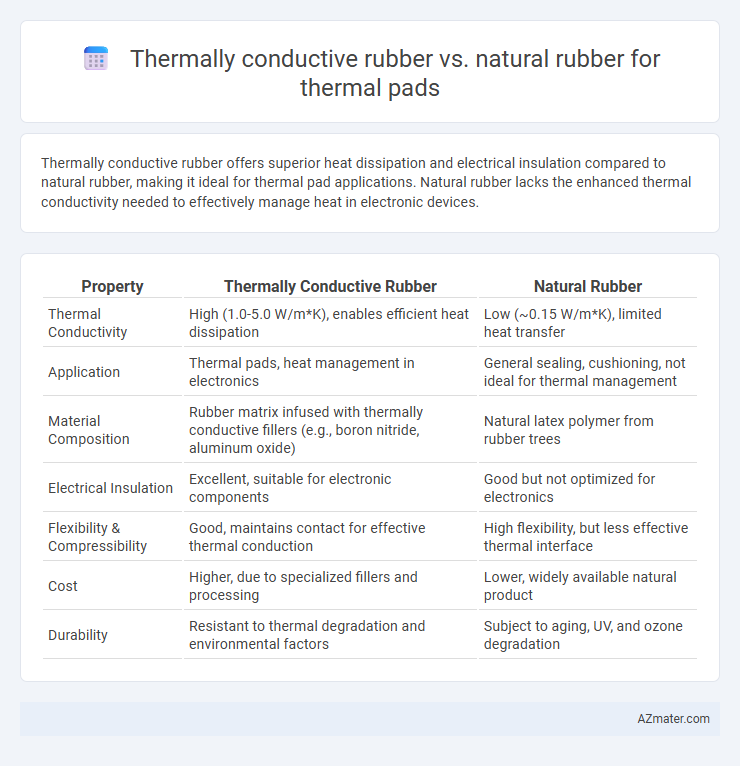Thermally conductive rubber offers superior heat dissipation and electrical insulation compared to natural rubber, making it ideal for thermal pad applications. Natural rubber lacks the enhanced thermal conductivity needed to effectively manage heat in electronic devices.
Table of Comparison
| Property | Thermally Conductive Rubber | Natural Rubber |
|---|---|---|
| Thermal Conductivity | High (1.0-5.0 W/m*K), enables efficient heat dissipation | Low (~0.15 W/m*K), limited heat transfer |
| Application | Thermal pads, heat management in electronics | General sealing, cushioning, not ideal for thermal management |
| Material Composition | Rubber matrix infused with thermally conductive fillers (e.g., boron nitride, aluminum oxide) | Natural latex polymer from rubber trees |
| Electrical Insulation | Excellent, suitable for electronic components | Good but not optimized for electronics |
| Flexibility & Compressibility | Good, maintains contact for effective thermal conduction | High flexibility, but less effective thermal interface |
| Cost | Higher, due to specialized fillers and processing | Lower, widely available natural product |
| Durability | Resistant to thermal degradation and environmental factors | Subject to aging, UV, and ozone degradation |
Introduction to Thermal Pads: Purpose and Materials
Thermal pads are essential components in electronic devices, designed to enhance heat dissipation between heat-generating elements and heat sinks. Thermally conductive rubber is engineered with fillers like boron nitride or aluminum oxide, offering superior thermal conductivity and electrical insulation compared to natural rubber. Natural rubber, while flexible and cost-effective, has low thermal conductivity, making it less efficient for high-performance thermal management applications.
Overview of Thermally Conductive Rubber
Thermally conductive rubber is engineered to enhance heat dissipation in electronic devices, offering superior thermal conductivity compared to natural rubber. It typically contains fillers such as boron nitride or aluminum oxide to facilitate efficient heat transfer while maintaining flexibility and electrical insulation. This material optimizes thermal management in applications requiring reliable heat dissipation and mechanical resilience.
Properties of Natural Rubber in Thermal Applications
Natural rubber in thermal pad applications offers excellent elasticity and flexibility, ensuring superior conformability to uneven surfaces for effective heat dissipation. Its inherent low thermal conductivity limits heat transfer efficiency compared to thermally conductive rubber but provides good electrical insulation properties. Natural rubber's biodegradability and resistance to environmental factors such as moisture and ozone make it suitable for sustainable and durable thermal interface materials.
Thermal Conductivity: A Comparative Analysis
Thermally conductive rubber exhibits significantly higher thermal conductivity, typically ranging from 1.0 to 5.0 W/mK, compared to natural rubber's low conductivity around 0.13 W/mK, making it more effective for heat dissipation in thermal pads. The enhanced thermal conductivity of thermally conductive rubber is achieved by embedding fillers like boron nitride, aluminum oxide, or silicone, which facilitate efficient heat transfer. In contrast, natural rubber's intrinsic molecular structure limits its thermal performance, rendering it less suitable for applications requiring rapid heat conduction.
Mechanical Performance and Flexibility
Thermally conductive rubber offers superior mechanical performance compared to natural rubber, featuring enhanced tensile strength and resistance to wear, which ensures durability in demanding thermal pad applications. Its flexibility remains high, enabling excellent conformability to uneven surfaces while maintaining consistent thermal conductivity. Natural rubber, while flexible and elastic, generally lacks the thermal conductivity and mechanical robustness required for efficient heat dissipation in electronic components.
Heat Dissipation Efficiency
Thermally conductive rubber exhibits significantly higher heat dissipation efficiency compared to natural rubber due to its enhanced thermal conductivity properties, typically ranging from 1 to 5 W/m*K, whereas natural rubber generally falls below 0.2 W/m*K. This improved heat transfer capability ensures effective thermal management in electronic devices, reducing hotspots and maintaining optimal operating temperatures. Consequently, thermally conductive rubber is preferred for thermal pads in applications demanding rapid and uniform heat dispersion.
Durability and Lifespan
Thermally conductive rubber exhibits superior durability and longer lifespan compared to natural rubber when used as thermal pads due to its enhanced resistance to heat degradation and mechanical stress. Natural rubber tends to harden and crack over time under prolonged thermal cycling, reducing its thermal conductivity and effectiveness. The advanced formulation of thermally conductive rubber maintains consistent performance in demanding environments, ensuring reliable thermal management for electronic components.
Applications in Electronics and Devices
Thermally conductive rubber offers superior heat dissipation properties compared to natural rubber, making it ideal for high-performance electronic devices such as CPUs, GPUs, and power modules where efficient thermal management is crucial. In contrast, natural rubber lacks the necessary thermal conductivity and is less effective in preventing overheating or maintaining device longevity in electronics applications. The advanced thermal conductivity of silicone-based or filled thermally conductive rubber enhances heat transfer, ensuring better protection and performance stability in sensitive electronic components.
Cost and Manufacturing Considerations
Thermally conductive rubber typically incurs higher material and processing costs compared to natural rubber due to specialized fillers such as boron nitride or aluminum oxide that enhance thermal conductivity. Manufacturing thermally conductive rubber requires precise mixing and curing processes to maintain consistent thermal and mechanical properties, increasing production complexity. Natural rubber remains more cost-effective and easier to process but lacks the enhanced heat dissipation necessary for advanced thermal pad applications.
Choosing the Right Material: Key Takeaways
Thermally conductive rubber offers superior heat dissipation with thermal conductivities typically ranging from 1 to 10 W/mK, making it ideal for high-performance thermal pads in electronics cooling. Natural rubber, while more flexible and cost-effective, generally has low thermal conductivity around 0.2 W/mK, limiting its effectiveness in thermal management applications. Selecting between these materials depends on balancing thermal performance requirements and mechanical properties such as flexibility and durability for optimized device cooling.

Infographic: Thermally conductive rubber vs Natural rubber for Thermal pad
 azmater.com
azmater.com